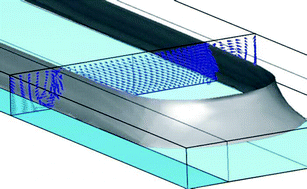We present a capillary flow system for liquid transport in microsystems. Our simple microfluidic system consists of two planar parallel surfaces, separated by spacers. One of the surfaces is entirely hydrophobic, the other mainly hydrophobic, but with hydrophilic pathways defined on it by photolithographic means. By controlling the wetting properties of the surfaces in this manner, the liquid can be confined to certain areas defined by the hydrophilic pathways. This technique eliminates the need for alignment of the two surfaces. Patterned plasma-polymerized hexafluoropropene constitutes the hydrophobic areas, whereas the untreated glass surface constitutes the hydrophilic pathways. We developed a theoretical model of the capillary flow and obtained analytical solutions which are in good agreement with the experimental results. The capillarity-driven microflow system was also used to pattern and immobilize biological material on planar substrates: well-defined 200 µm wide strips of human cells (HeLa) and fluorescence labelled proteins (fluorescein isothiocyanate-labelled bovine serum albumin, i.e., FITC-BSA) were fabricated using the capillary flow system presented here.

You have access to this article
 Please wait while we load your content...
Something went wrong. Try again?
Please wait while we load your content...
Something went wrong. Try again?


 Please wait while we load your content...
Please wait while we load your content...